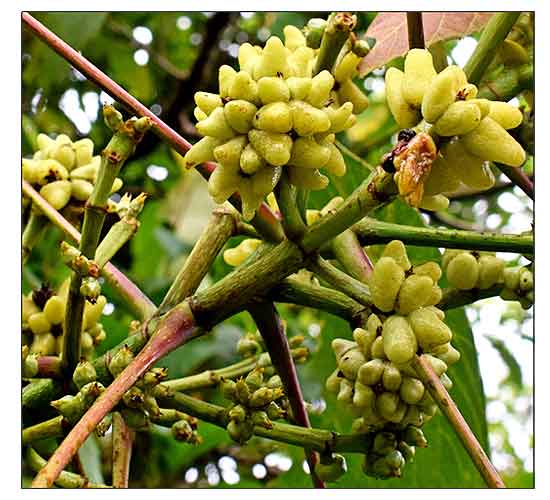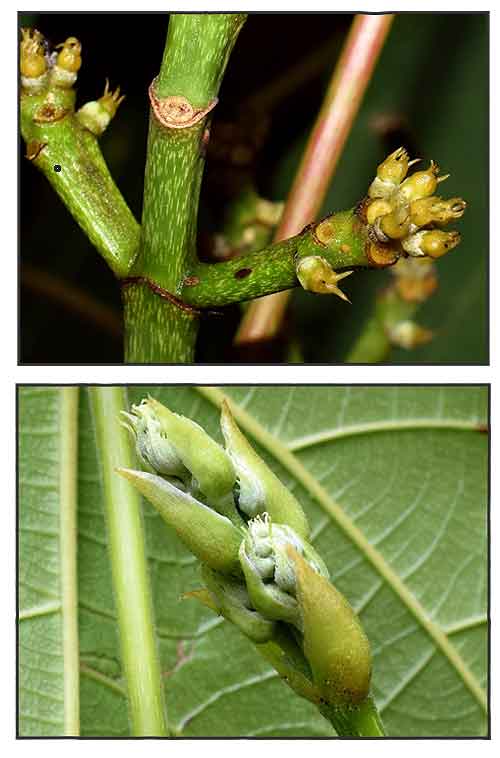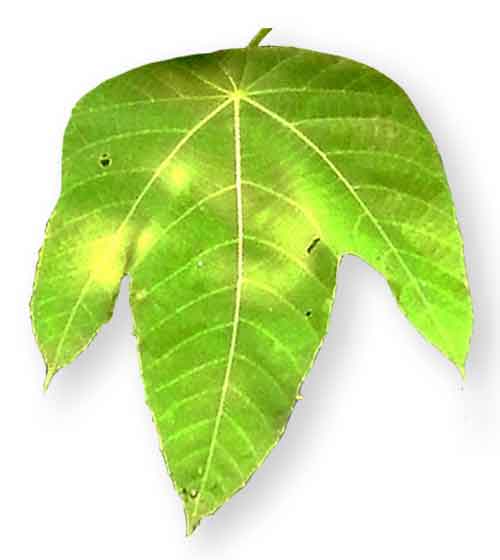 Gen info Gen info
- Macaranga is a large genus of the Old World tropical trees of the family Euphorbiaceae and the only genus in the subtribe Macaranginae (tribe Acalyphae).
-
Macaranga triloba is a species of plant in the family Euphorbiaceae, native to the tropical forests of southeastern Asia. It is a pioneer species, colonizing recently cleared or burnt areas of the forest. (2)
Botany
• M. triloba is a small, spreading tree, growing to a height of about 20 m (66 ft). The trunk is a light grayish-brown with smooth bark, and the twigs and shoots are largely devoid of hairs. The leaves are tri-lobed and peltate, with toothed margins. Each leaf has two erect, leathery stipules that are ovate, slightly recurved and do not encircle the stem. The inflorescence is a panicle with minute reddish-brown flowers. The fruits are rounded, sticky and yellow when ripe, the carpels developing long, horn-like processes. The fruits are about 12 mm (0.5 in) long and 7 mm (0.3 in) wide. (2)
• The plant has a mutualistic relationship with predatory ants of the Crematogaster genus. The tree has hollow twigs and stems that provide nesting space for ants and food bodies located on the leaf stipules that the ants feed on, at the same time defending the tree against herbivorous insects. (2)
• A small to medium-sized tree up to 20 m tall, stems solid; leaves 3(-5)-lobed, 15-35 cm x 12-24(-30) cm, lobes broadly ovate, glandular-dentate, densely hairy but later glabrescent above, deeply peltate, stipules up to 15 mm long, spreading, persistent; male flowers in slender, lax, branched panicles up to 22 cm long, with 1 stamen, female flowers with 4-5-celled ovary, styles connate into an ovoid, hollow body; fruit up to 8 mm long, with 4-5 hornlike processes. M. triloba occurs in a wide range of habitats, including dryland dipterocarp forest and edges of swampy forest, up to 1400 m altitude; it is locally very common, e.g. in Java.
Distribution
- Native to the
Philippines.
- Along forested river banks.
- Also native to Borneo, Cambodia, Jawa, Malaya, Myanmar, Nicobar Is., Sumatera, Thailand. (1)
 Constituents Constituents
- Activity-guided fractionation of leaves, using an in-vitro bioassay bases on inhibition of cyclooxygenase-2, isolated a rotenoid, 4,5-dihydro-5'alpha-hydroxy-4'alpha-methoxy-6a,12a-dehydro-alpha-toxicarol (1), along with 12 known compounds, (+)-clovan-2β,9α-diol, ferulic acid, 3,7,3′,4′-tetramethylquercetin, 3,7,3′-trimethylquercetin, 3,7-dimethylquercetin, abscisic acid, 1β,6α-dihydroxy-4(15)-eudesmene, 3β-hydroxy-24-ethylcholest-5-en-7-one, loliolide, scopoletin, taraxerol, and 3-epi-taraxerol. (see study below) (4)
- Study of dichloromethane extract of flowers yielded four flavanone compounds:
6-prenyl-3'-methoxy-eriodictyol (1), nymphaeol-B (2), nymphaeol-C (3) and 6-farnesyl-3',4',5,7-tetrahydroxyflavanone (4). (8)
- Study of Mahang leaves yielded
total flavonoid content of 0.603 ppm. (9)
- Study of leaves isolated a new geranyl flavanone, 2'-hydroxy-macarangaflavnone A (1), and a known 4',7-dihydroxy-8-methylflavan. (10)
- Study of dichloromethane extract of M. triloba inflorescences isolated a new flavanone derivative, malaysianone A (1), four prenylated flavanones, 6-prenyl-3′-methoxyeriodictyol (2), nymphaeol B (3), nymphaeol C (4) and 6-farnesyl-3′,4′,5,7-tetrahydroxyflavanone (5), and two coumarins, 5,7-dihydroxycoumarin (6) and scopoletin (7). (see study below)
(12)
- Isolation and purification studies of M. triloba flowers afforded seven compounds comrpising five flavonoids, 6-prenyl-3'-methoxy-eriodictyol (1), nymphaeol-B (2), flavonoid DL 4 (3), nymphaeol-C (4) and 6-farnesyl-3',4',5,7-tetrahydroxyflavanone (5), and two coumarins, 5,7- dihydroxycoumarin (6) and scopoletin (7).
(13)
Properties
- Studies have suggested cancer chemopreventive, antioxidant, antibacterial, antiplasmodial properties.
 Parts used Parts used
Leaves, roots.
Uses
Edibility
- In Thailand, young shoots are eaten as vegetable.
- In China and Taiwan, dried leaves are used in herbal tea preparations.
Folkloric
- No reported folkloric medicinal use in the Philippines.
- In Thai and Malaysian traditional medicine, decoction of roots used as antipyretic and antitussive. Dried roots used as emetic; while fresh leaves used to cover wounds to prevent inflammation.
Among the aboriginal tribes of Sabah and Sarawak (Borneo), sap from young shoots used to treat fungal infections, and leaf decoction used for stomach aches. (5)
- In Kalimantan, used by locals for treatment of diabetes.
Wood:
- Fuel: Wood used as firewood.
Studies
• Cancer Chemopreventive / Anti-Inflammatory / Leaves: Activity-guided fractionation of leaves, using an in-vitro bioassay based on inhibition of cyclooxygenase-2, isolated a rotenoid, 4,5-dihydro-5'alpha-hydroxy-4'alpha-methoxy-6a,12a-dehydro-alpha-toxicarol (1), along with 12 known compounds. All isolates were evaluated for potential to inhibit COX-1 and -2 by measuring PGE2 production, and to induce quinone reductase in cultured Hepa 1c1c7 mouse hepatoma cells.
Compounds 4-6 are structurally related to known flavonoid quinone reductase (QR) inducers. QR is a phase II detoxifying enzyme and its induction is considered an important cancer chemorpreventive mechanism at the initiation stage. Inhibition of COX-2 as a mechanism for cancer chemoprevention has been supported by epidemiological and experimental evidence. (see constituents above) (4)
• Antioxidant / Antibacterial / Leaves: Study evaluated the methanolic fresh leaf extracts of four Macaranga species: Macaranga triloba, M. gigantea, M. pruinosa, and M. tanarius, using TPC, DPPH, FRAP, ferrous iron chelating, and lipid peroxidation inhibition (LPI) activity for antioxidant properties. Total phenolic content showed no significant differences. M. triloba showed highest ascorbic acid equivalent antioxidant activity (AEAC), FRAP, and LPI. On antibacterial activity using disc diffusion technique, Macaranga triloba also showed best antibacterial activity against Gram(+) bacteria, with minimum inhibition dosage (MID) values as low as 10 µg/disc. (5) Study of hexane leaf extract for antimicrobial activity using agar disc-diffusion and well-diffusion methods showed activity against Staphylococcus aureus. Compared to ascorbic acid as positive control, the hexane extract showed twice higher antioxidant activity than a methanol extract. (11)
• Antioxidant / Leaves: Study evaluated the antioxidant activity of ethyl acetate fraction of M. triloba leaves. The EA fraction yielded flavonoids and alkaloids. Antioxidant activity of EA fraction showed IC50 56.93 ppm, weaker than quercetin (IC50 - 4.46 ppm), but still within range of strong antioxidant activity (50-100 ppm). (6)
• Antiplasmodial / Anticancer / Flowers: Study of dichloromethane extract of M. triloba inflorescences isolated a new flavanone derivative, malaysianone A (1), four prenylated flavanones, 6-prenyl-3′-methoxyeriodictyol (2), nymphaeol B (3), nymphaeol C (4) and 6-farnesyl-3′,4′,5,7-tetrahydroxyflavanone (5), and two coumarins, 5,7-dihydroxycoumarin (6) and scopoletin (7). Compound 5 showed cytotoxicity by strongly inhibiting growth of HeLa and HL-60 cells with IC50s of 1.3 µg/ml and 3.3 µg/ml, respectively. Compound 5 showed strong antiplasmodial activity with IC50 of 0.06 µM. (12)
• Effect on Dysmenorrhea / Leaves: Study evaluated the effect of macaranga leaf capsule as complementary therapy for dysmenorrhea in 60 patients. Results showed decrease in dysmenorrhea pain in 57 respondents, statistically significant (p<0.001). Effect was attributed to antioxidants in the leaves. (14)
Availability
- Wild-crafted.
|

![]()




 Constituents
Constituents
